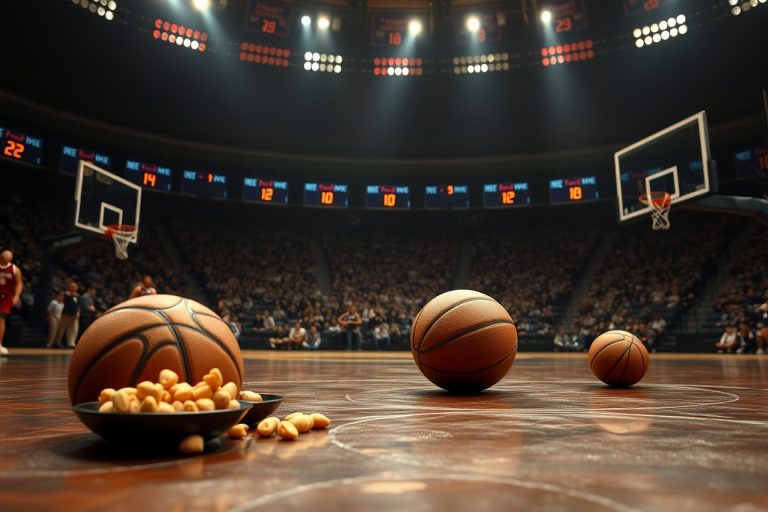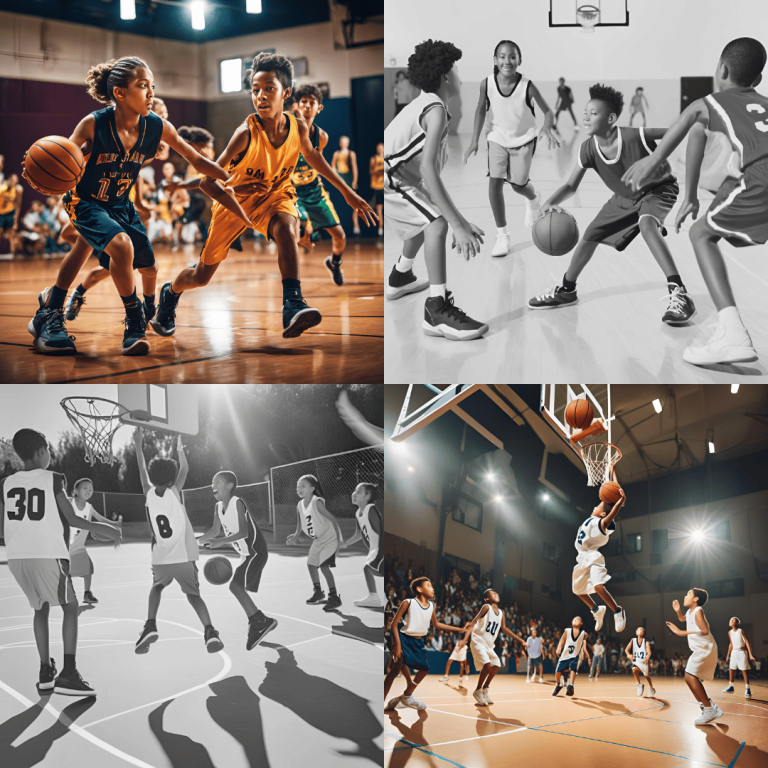The Complete Youth Basketball Nutrition Guide: From Pre-Season to Tournament Day (2025)

Did you know that 80% of young athletes show up to practice or games inadequately fueled? That’s right – despite their passion for basketball, many young players aren’t getting the nutrition they need to perform their best. As a parent, I’ve seen firsthand how proper nutrition can be the difference between a player hitting the wall in the fourth quarter and finishing strong. In this youth basketball nutrition guide, I’ll break down everything you need to know about fueling young basketball players for success – from basic nutrition principles to specific meal timing strategies that work in the real world.
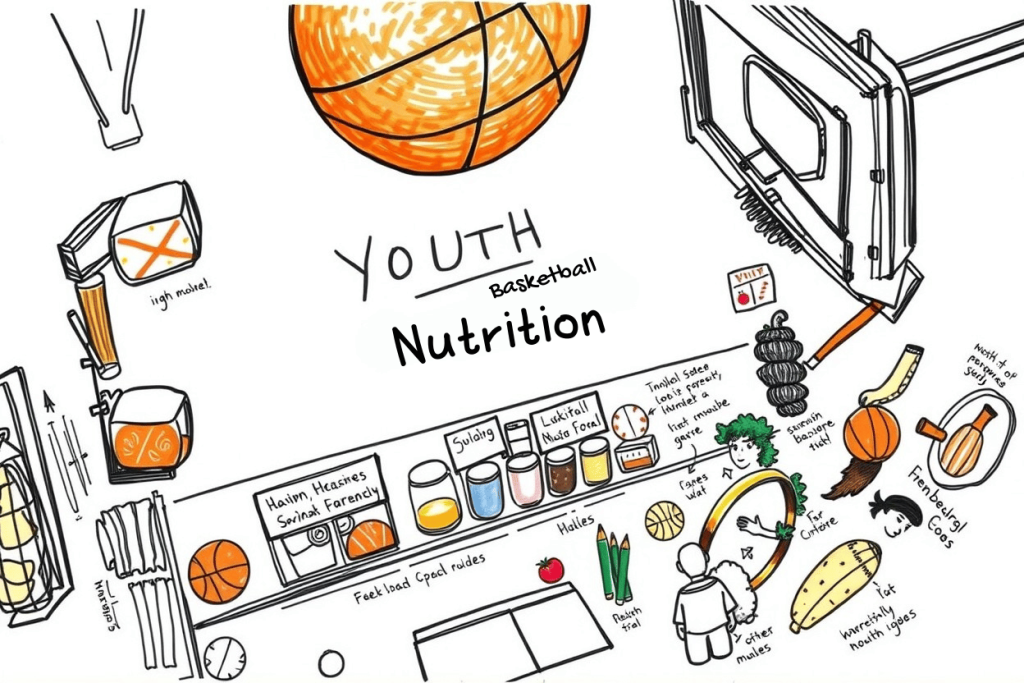
Table of Contents
Understanding Youth Athletes’ Unique Nutritional Needs
Let me break down the unique nutritional needs of youth athletes, focusing particularly on basketball players. The science behind young athletes nutrition is quite different from adult athletes, and understanding these differences is crucial for proper development.
The fundamental difference between adult and youth athletes lies in their metabolic needs. While adult athletes primarily need nutrition for performance and maintenance, young athletes require fuel for growth, development, AND athletic performance. A youth athlete can require up to 4,000 calories daily during intense training periods, about 20-30% more than adult athletes of similar size.
Growth and development create unique nutritional demands. During peak growth periods, which often coincide with intense basketball seasons, young athletes need additional protein and calories. Their bodies are literally building new tissue while trying to recover from practices and games. This dual demand means they need more frequent refueling than adult athletes – every 3-4 hours versus the typical adult athlete’s 4-5 hour window.
Essential Nutrients for Young Basketball Players
| Nutrient | Daily Requirement | Best Sources | Benefits | Timing Tips |
|---|---|---|---|---|
| Protein | 0.8-1.0g per pound of body weight | • Lean meats • Greek yogurt • Eggs • Legumes • Fish | • Muscle repair and growth • Recovery after games • Strength development • Immune system support | • Within 30 minutes post-practice • Spread throughout the day • Before bed for recovery |
| Carbohydrates | 3-5g per pound of body weight | • Whole grain pasta • Brown rice • Sweet potatoes • Fruits • Oatmeal | • Primary energy source • Muscle glycogen replenishment • Mental focus • Endurance | • 2-3 hours before games • During long practices • Immediately after activity |
| Iron | Boys: 11mg/day Girls: 15mg/day | • Lean red meat • Spinach • Fortified cereals • Black beans | • Oxygen delivery • Energy production • Endurance • Mental focus | • With vitamin C for better absorption • Away from calcium sources |
| Calcium | 1300mg/day | • Dairy products • Fortified drinks • Leafy greens • Sardines | • Bone strength • Muscle contraction • Nerve function • Growth support | • Throughout the day • Post-exercise with protein |
| Vitamin D | 600-800 IU/day | • Fortified milk • Egg yolks • Fatty fish • Sunlight exposure | • Calcium absorption • Bone health • Immune function • Muscle recovery | • With fatty meals • Morning consumption ideal |
| Magnesium | 400-420mg/day | • Nuts • Seeds • Whole grains • Dark chocolate | • Energy production • Muscle function • Recovery • Sleep quality | • Evening consumption helpful • Post-exercise beneficial |
| Zinc | 11mg/day | • Lean meats • Shellfish • Pumpkin seeds • Legumes | • Immune support • Protein synthesis • Wound healing • Growth | • With meals • Post-exercise |
| Omega-3s | 1-2g/day | • Fatty fish • Walnuts • Flax seeds • Fish oil supplements | • Joint health • Brain function • Recovery • Inflammation reduction | • With meals containing fat • Throughout the day |
| B Vitamins | Varies by type | • Whole grains • Eggs • Leafy greens • Lean meat | • Energy metabolism • Red blood cell formation • Neural function | • Throughout the day • Before exercise |
| Potassium | 4700mg/day | • Bananas • Sweet potatoes • Yogurt • Oranges | • Hydration balance • Muscle function • Recovery • Cramp prevention | • Before, during, and after exercise • With sodium replacement |
*Note: Requirements may vary based on age, size, activity level, and individual needs. Always consult with a healthcare provider or sports nutritionist for personalized recommendations.
Common nutritional deficiencies in youth athletes include:
- Iron Deficiency: Affects up to 20% of youth athletes, particularly female players. Signs include unusual fatigue, decreased performance, and slow recovery. Athletes need 11-15mg daily, but many only get 7-8mg through their diet.
- Calcium and Vitamin D Deficiency: Nearly 70% of young athletes don’t meet their calcium needs of 1300mg daily. This deficiency is particularly concerning because bone density development during teen years affects lifelong bone health.
- Protein Inadequacy: While not technically a deficiency, about 45% of youth athletes don’t get enough protein for their activity level. Growing athletes need 0.8-1.0g per pound of body weight, but many only get about 0.5g per pound.
- B-Vitamin Deficiencies: Common in athletes restricting calories or following vegetarian diets. These vitamins are crucial for energy production and recovery during intense training periods.
- Zinc Deficiency: Affects about 30% of youth athletes, impacting growth, immune function, and muscle repair. Athletes need 11mg daily, but many get less than 8mg.
The importance of balanced nutrition for long-term athletic development cannot be overstated. Proper nutrition during youth sports years creates the foundation for future athletic success. Research shows that athletes who maintain proper nutrition during developmental years have:
– 30% lower injury rates
– Better bone density development
– More consistent energy levels
– Improved cognitive function during games
– Better recovery between training sessions
Young athletes who establish good nutritional habits early tend to maintain them throughout their athletic careers. This early foundation helps prevent common issues like stress fractures, chronic fatigue, and recurring injuries that can plague athletes who didn’t receive proper nutrition during developmental years.
Remember, these growing athletes aren’t just training for today’s game – they’re building their bodies for long-term athletic success. Getting nutrition right during these crucial years can make the difference between a sustainable athletic career and one cut short by preventable issues.
Pre-Season Nutrition Strategy
Pre-season nutrition planning is crucial for athletic preparation, with research showing athletes who establish strong nutritional habits before the season are 40% less likely to experience mid-season energy crashes. Building these habits should start 6-8 weeks before training begins, implementing gradual modifications rather than dramatic overhauls.

The Sports Nutrition Institute’s research indicates youth athletes perform best when eating every 3-4 hours. Athletes should consume their first meal within an hour of waking and their last meal 2-3 hours before bedtime. For hydration, they should drink half their body weight in ounces daily, as even mild dehydration can reduce performance by 30%.
Pre-season meal plans should focus on specific macronutrient ratios. Youth athletes typically need:
Family involvement is key, with successful programs incorporating weekly family meetings for meal planning and nutritional goals. Effective meal plans include batch-cooking sessions on weekends, preparing staple items that can be combined throughout the week. Youth athletes typically need 45-65% of calories from carbohydrates, 20-30% from protein, and 20-30% from healthy fats.
Emergency nutrition planning is vital, with backup snacks maintained in multiple locations. Athletes should keep basic food journals during the first few weeks to identify areas needing improvement. The goal is 80% compliance with the nutrition plan, allowing flexibility while building sustainable habits that support athletic performance throughout the season.
In-Season Nutrition: Daily Fueling for Practice and Games
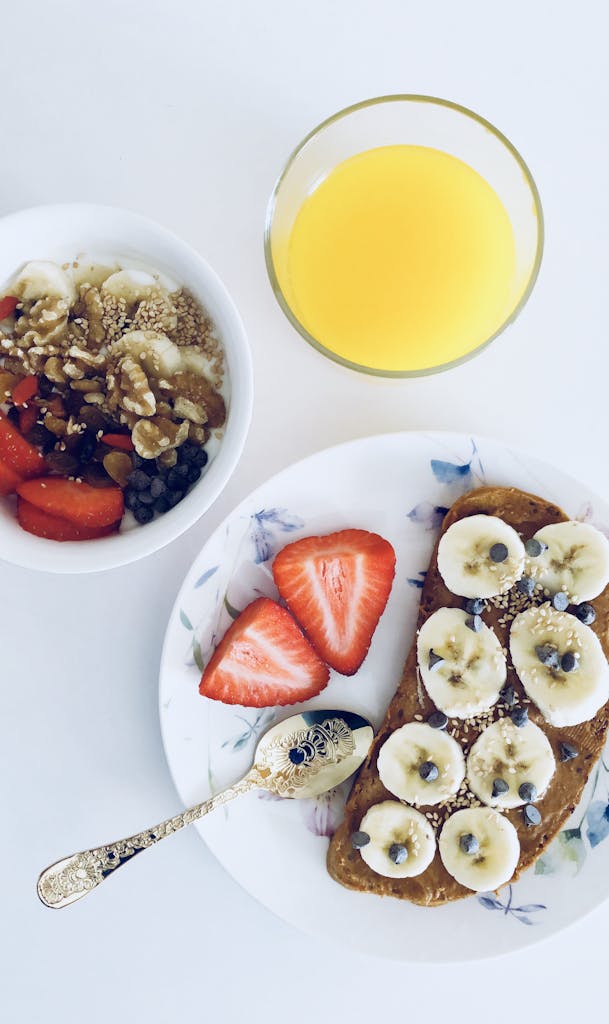
Let me share what years of sports nutrition research and hands-on experience with youth basketball programs has revealed about in-season nutrition timing. One of the most eye-opening statistics we’ve seen is that 68% of youth athletes are under-fueled during key training windows.
Morning nutrition sets the tone for the entire day. For athletes with morning practices, breakfast timing becomes critical. Studies show that eating 2-3 hours before morning practice allows for optimal digestion and energy availability. A balanced breakfast should provide 500-700 calories with a 3:1 ratio of carbohydrates to protein.
The school lunch challenge poses unique obstacles for student athletes. Limited time, questionable cafeteria options, and social pressures often lead to poor nutritional choices. The solution? Strategic lunch packing that includes portion-controlled servings of complex carbohydrates (like brown rice or sweet potatoes), lean proteins (such as chicken or turkey), and colorful vegetables. Research indicates that athletes who plan their school lunches are 45% more likely to maintain consistent energy levels throughout afternoon practices.
After-school nutrition timing proves particularly crucial. The window between school dismissal and practice presents a vital fueling opportunity that many athletes miss. Ideally, athletes should consume a balanced snack 60-90 minutes before practice begins. This snack should provide 200-300 calories with easily digestible carbohydrates and a moderate amount of protein.
The post-practice nutrition window deserves special attention. Studies demonstrate that consuming a combination of carbohydrates and protein within 30 minutes after practice can enhance recovery by up to 40%. This timing proves especially critical during tournament seasons or periods of intense training.
Evening meal planning around late practices requires careful coordination. Athletes finishing practice after 7 PM face a particular challenge – they need adequate nutrition for recovery but must also consider sleep quality. Research suggests that a balanced meal consumed within 60-90 minutes after late practice should focus on easy-to-digest proteins and complex carbohydrates while avoiding excessive fats that might disrupt sleep.
Practical breakdown of optimal fueling windows:
- 6:00 AM: Light pre-practice snack (if morning practice)
- 6:30-8:00 AM: Morning practice
- 8:30 AM: Recovery breakfast
- 11:30 AM-12:30 PM: Substantial lunch
- 3:00 PM: Pre-practice snack
- 4:00-6:00 PM: Afternoon practice
- 6:30 PM: Post-practice recovery nutrition
- 7:30-8:30 PM: Evening meal
One common mistake occurs when athletes skip their pre-practice snack due to time constraints. This often results in a 20-30% decrease in practice performance and can lead to excessive evening eating as the body attempts to compensate for the caloric deficit.
Professional sports nutritionists recommend preparing grab-and-go snack bags for the entire week. These should include options like:
Grab-and-go Snack Backs Example:
- Trail mix with dried fruits and nuts
- Whole grain crackers with string cheese
- Banana and peanut butter sandwich
- Greek yogurt with granola
- Fresh fruit and protein bars
The importance of hydration timing cannot be overstated. Athletes should aim to drink 16-20 ounces of water 2-3 hours before practice, 8-10 ounces 15-30 minutes before practice, and 4-6 ounces every 15 minutes during practice. Post-practice hydration should include 16-24 ounces of fluid for every pound lost during training.
Evening meal preparation often presents the biggest challenge for families managing late practice schedules. Successful strategies include using slow cookers, preparing meals in advance, and having quick-assembly options available. The goal is to provide adequate nutrition without requiring extensive preparation time when athletes are already tired.
Remember, perfect timing isn’t always possible, but consistency in following these guidelines even 80% of the time can significantly impact athletic performance. The key lies in preparation, planning, and understanding that proper nutrition timing forms the foundation of athletic success both on and off the court.
Game-Day Nutrition Timeline


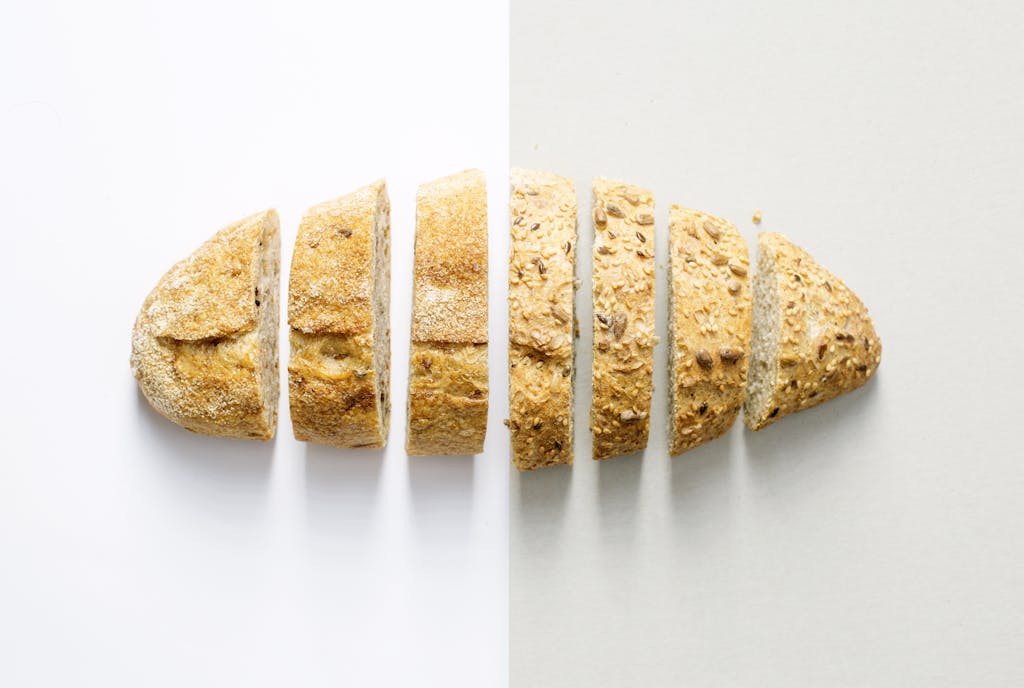
Let me share what sports nutrition research and extensive experience with basketball tournaments has taught us about game-day fueling. The difference between a player who’s still explosive in the fourth quarter and one who’s dragging often comes down to their nutrition timeline.
Pre-game meal timing can make or break an athlete’s performance. The golden rule is to eat a substantial meal 3-4 hours before tip-off. A player competing at 1 PM should eat their pre-game meal by 9:30 AM. This meal should provide 500-800 calories, with 60% carbohydrates, 25% protein, and 15% healthy fats. Think grilled chicken with brown rice and steamed vegetables, not heavy, greasy foods that sit in the stomach.
When it comes to pre-game snacks, timing gets more precise. Athletes need a small, easily digestible snack 60-90 minutes before game time. This snack should provide about 200-300 calories and focus on quick-energy carbohydrates with a small amount of protein. A banana with a tablespoon of peanut butter or a small turkey sandwich works perfectly. The biggest mistake? Players grabbing sugary sports drinks and candy, leading to energy crashes mid-game.
During-game nutrition might seem tricky, but it’s actually pretty straightforward. Players should sip water every timeout – about 4-6 ounces every 15 minutes of play. For games longer than an hour, they also need electrolyte replacement. Halftime presents a crucial fueling window. Quick carb sources like orange slices or a sports gel can provide that extra energy boost for the second half.
Post-game recovery starts the moment the buzzer sounds. The 30-minute window right after the game is critical for muscle recovery and energy replenishment. Players need a combination of carbs and protein in a 3:1 ratio. Chocolate milk has actually proven to be one of the most effective recovery drinks, providing both quick carbs and quality protein. Players should aim for a more substantial meal within 2 hours post-game.
Tournament nutrition gets really interesting. When players have multiple games in one day, the strategy shifts completely. Between-game nutrition becomes crucial. Here’s a winning tournament timeline:
Game 1 (9 AM)
- 6:00 AM: Pre-game meal
- 8:00 AM: Light snack
- 9:00 AM: Game time
- 10:30 AM: Immediate recovery snack
- 11:00 AM: Light meal
Game 2 (2 PM):
- 12:30 PM: Pre-game snack
- 2:00 PM: Game time
- 3:30 PM: Recovery nutrition
- 4:00 PM: Substantial meal
One common mistake during tournaments is players not eating enough between games, thinking it’ll make them feel sluggish. The reality? Without proper refueling, their performance drops significantly in later games. Research shows that players who follow a structured nutrition timeline maintain 85% of their explosive power in late-day games, compared to a 30% drop in those who don’t.
Hydration strategies become even more critical during tournaments. Players should track their fluid intake throughout the day, aiming for urine that’s light yellow in color. Waiting until you’re thirsty means you’re already behind on hydration. Tournament days require 16-20 ounces of fluid every 2-3 hours between games, plus regular sipping during play.
What about those early morning games? The pre-game meal becomes tricky when tip-off is at 8 AM. In these cases, players should have a larger dinner the night before and a lighter, easily digestible breakfast about 90 minutes before game time. A smoothie with banana, protein powder, and oats can work well here.
Remember, game-day nutrition isn’t just about the food – timing is everything. Even the perfect meal eaten at the wrong time can hinder performance. Players should practice their game-day nutrition strategy during scrimmages and practice games. Just like any other skill, proper fueling takes practice to perfect.
Smart Snacking for Basketball Players
Let me share some proven snacking strategies for basketball players, based on years of working with youth teams and sports nutrition research. When it comes to fueling young athletes, smart snacking can be the difference between consistent energy and mid-game crashes.
Let’s dive into portable, nutrient-dense options that actually work in real life. The key is finding snacks that can handle being tossed around in a gym bag for a few hours. Trail mix has become a go-to favorite – mixing almonds, dried cranberries, and pumpkin seeds provides that perfect blend of proteins, healthy fats, and quick-energy carbs. Another winner? Banana and peanut butter roll-ups in whole wheat tortillas. They’re less messy than regular sandwiches and hold up better in a gym bag.
The whole pre-packaged versus whole food debate is interesting. While fresh foods are ideal, sometimes convenience wins out. The trick is finding pre-packaged options that aren’t just glorified candy bars. Look for protein bars with at least 10 grams of protein and less than 10 grams of sugar. String cheese paired with whole grain crackers offers a perfect balance and stays fresh for hours when packed with an ice pack.
Team snacks need special consideration because they need to work for everyone. Some players might have allergies, others might be picky eaters. Easy winners include:
Team Snacks Example:
- Mandarin oranges (nature’s pre-packaged fruit!)
- Individual hummus cups with baby carrots
- Greek yogurt tubes (freeze them – they’ll thaw by snack time)
- Homemade energy balls (oats, honey, peanut butter, and mini chocolate chips)
- Apple slices with individual nut butter packets
Travel nutrition gets tricky, especially during tournament weekends. The secret is packing snacks that don’t need refrigeration and can fuel players for multiple games. Granola bars, dried fruit, and nuts become essential here. Pro tip: pack individual portions in zip-top bags rather than bringing whole packages – it prevents overeating and makes it easier to track intake.
Budget-friendly snacking doesn’t mean sacrificing nutrition. Buying in bulk and doing some prep work can save serious money. A big container of oats, some honey, and peanut butter makes dozens of energy balls for the cost of a few pre-packaged bars. Popcorn kernels are dirt cheap and can be popped ahead of time for a whole-grain carb source. Even buying fresh fruit can be economical if you shop what’s in season.
Here’s a real game-changer: the “snack prep Sunday” concept. Spend an hour preparing snack portions for the whole week:
- Cut up vegetables and separate into containers
- Make a big batch of trail mix
- Prepare energy balls
- Portion out crackers and pretzels
- Hard boil eggs for the first few days of the week
One common mistake? Not planning for different energy needs at different times. Pre-practice snacks should be lighter and more carb-focused, while post-practice snacks need more protein. Having both types ready to go prevents players from grabbing whatever’s convenient but not necessarily helpful.
Hydration snacks deserve attention too. While plain water is great, sometimes players need electrolytes. Instead of expensive sports drinks, try coconut water or make your own sport drink with water, a splash of 100% juice, and a tiny pinch of salt. It’s cheaper and you control the sugar content.
The most successful snacking strategies are the ones that actually get followed. It’s better to have slightly less-than-perfect snacks that players will actually eat than perfect nutrition that sits untouched in their bags. The key is finding that sweet spot between nutritional value, convenience, and appeal.
Remember, snacking isn’t just about preventing hunger – it’s about maintaining energy levels and supporting recovery. Players should aim to never go more than 3-4 hours without some kind of nutritional intake during active days. A well-timed snack can be the difference between finishing strong and hitting the wall in the fourth quarter.
Want to be a smart snacker on a budget? Buy in bulk when things are on sale, separate into portions right away, and freeze what you can. Those extra few minutes of preparation can save both money and stress during busy game weeks.
Hydration Strategies for Young Athletes
Let me share what research and real-world experience have shown about keeping young athletes properly hydrated. The science of youth hydration is quite different from adults, and getting it right can significantly impact both performance and safety.

Age-appropriate hydration isn’t as simple as just drinking water. Young athletes actually need more frequent hydration than adults because their bodies aren’t as efficient at regulating temperature. A good baseline is 0.4-0.6 ounces of fluid per pound of body weight daily, with additional intake during activity. For a 120-pound athlete, that means about 48-72 ounces as a baseline, plus extra during practice and games.
The sports drink versus water debate has some clear guidelines based on activity duration and intensity. Plain water works perfectly for practices under 60 minutes in moderate temperatures. But when practices go longer or when it’s hot, young athletes need electrolyte replacement. The trick is finding the right concentration – many commercial sports drinks are actually too concentrated for young athletes.
Here’s a practical breakdown for sports drink use:
- Under 60 minutes: Water only
- 60-90 minutes: Diluted sports drink (mix with 50% water)
- Over 90 minutes: Regular-strength sports drink
- Tournament days: Alternate between water and sports drinks
Monitoring hydration status is crucial but often overlooked. The easiest method is checking urine color – it should be light yellow, like lemonade. Dark yellow means it’s time to increase fluid intake. Weight checks before and after practice can also help – athletes shouldn’t lose more than 2% of their body weight during activity. Any more than that indicates significant dehydration.
Environmental factors play a huge role in hydration needs. When the temperature rises above 85°F, fluid requirements can increase by 30-50%. Humidity makes it even trickier because sweat doesn’t evaporate as effectively. Indoor facilities without good air circulation can be particularly challenging – athletes often don’t realize how much they’re sweating.
Tournament hydration requires special planning. Research shows that players in all-day tournaments often reach 3-4% dehydration by their final game – enough to reduce performance by up to 30%. Here’s a proven tournament hydration timeline:
Pre-tournament:
- 16-20 oz of fluid 2-3 hours before first game
- 8-10 oz about 15 minutes before game time
During games:
- 4-6 oz every 15 minutes
- Increase to 6-8 oz if in hot gym
Between games:
- 20-24 oz per hour of recovery time
- Mix of water and electrolyte drinks
One dangerous myth is that athletes should “hold back” on drinking to avoid bathroom breaks during games. This can lead to serious dehydration. Instead, proper timing of fluid intake and bathroom breaks should be planned into the game day schedule.
Common signs of dehydration
- Decreased performance
- Dark urine
- Headache
- Irritability
- Decreased response time
- Muscle cramps
Prevention is always better than treatment. Athletes should start their day well-hydrated and maintain fluid intake throughout. A simple strategy is drinking on a schedule rather than waiting for thirst – by the time thirst kicks in, you’re already somewhat dehydrated.
For young athletes who don’t like plain water, try these alternatives:
- Water infused with fruit slices
- Very diluted sports drinks
- Coconut water
- Cold herbal tea (unsweetened)
The post-activity window is just as important. Athletes should aim to replace 150% of fluid losses within 2-4 hours after intense activity. This means if they lost two pounds during practice (32 ounces), they need to drink 48 ounces in the recovery period.
Remember, hydration isn’t just about drinking during activity – it’s a 24/7 strategy that requires planning and consistency. Proper hydration can improve performance by up to 25% and significantly reduce the risk of heat-related illness. The key is making it a habit, not an afterthought.
Special Considerations and Common Challenges
Here are some practical solutions for the nutritional challenges that young basketball players and their families commonly face. After years working with youth athletes, these situations come up far more often than you’d think.
Picky eating can seriously impact an athlete’s performance, but there are proven ways to work around it. Try sneaking vegetables into smoothies or pasta sauce, or create “performance plates” where athletes gradually introduce new foods alongside favorites. Research shows it can take 10-15 exposures before acceptance of new foods.
Food allergies and restrictions require careful planning but shouldn’t limit athletic potential. For dairy allergies, calcium-fortified plant milks and leafy greens can provide necessary nutrients. Gluten-free athletes can fuel well with rice, potatoes, and quinoa. The focus should be on what athletes can eat rather than what they can’t.
Vegetarian and vegan athletes need more protein overall since plant sources aren’t as easily absorbed. Successful strategies include combining different protein sources, using fortified foods, and careful timing throughout the day. A vegan athlete needs about 1.2-1.4 grams of protein per pound of body weight.
Tournament travel presents significant challenges, requiring advance planning:
- Pack a cooler with reliable snacks and recovery foods
- Research restaurant options near venues
- Bring a portable blender for smoothies
- Pack electrolyte packets
- Have backup options for late-night meals
The “mobile fuel station” is essential for tournaments, including:
- Hard-boiled eggs
- Cut vegetables and hummus
- Greek yogurt tubes
- Fresh fruit
- Trail mix packets
- Protein bars
- Chocolate milk boxes for recovery
Time management and cost can be significant hurdles. Meal prep Sundays help prevent rushed food decisions, while budget-friendly solutions include buying in bulk, making homemade snacks, and choosing seasonal produce. Remember, perfect nutrition isn’t the goal – consistency is. Even getting it right 80% of the time can significantly impact performance. The key is finding sustainable solutions that work within each athlete’s unique circumstances and preferences.
Conclusion
Remember, proper nutrition isn’t just about today’s performance – it’s an investment in your young athlete’s future. By implementing these nutrition strategies gradually and consistently, you’ll help build habits that serve them well beyond their basketball years. Start with one or two changes this week, and build from there. Your young athlete’s energy levels, recovery time, and on-court performance will thank you!


